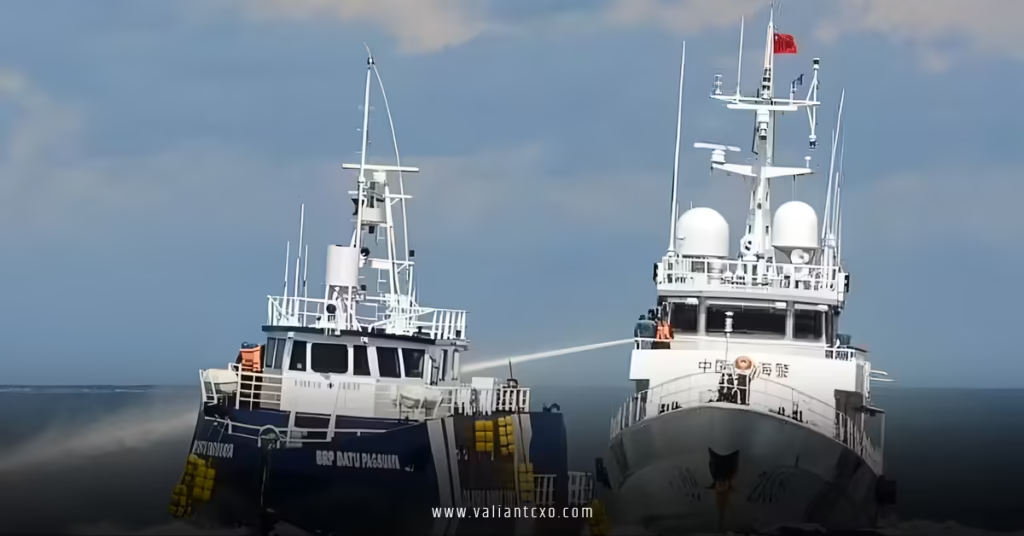Philippines China South China Sea clash, a geopolitical showdown that’s been simmering for decades but boiled over again just days ago on October 12, 2025. As a casual observer of global hotspots, I’ve always found these maritime tussles fascinating—like watching a high-stakes poker game where the chips are islands, oil reserves, and the future of trade routes. But let’s dive deeper; why should you care? Because this isn’t just about two neighbors squabbling over a reef—it’s a powder keg that could ripple through your daily life, from the price of fish on your plate to the stability of the world’s shipping lanes. Stick with me as we unpack this tangle of history, fury, and fragile diplomacy.
The Roots of the Philippines China South China Sea Clash: A Legacy of Overlapping Ambitions
Ever wonder how a serene stretch of blue water turns into a battleground? The Philippines China South China Sea clash didn’t erupt overnight; it’s woven into the fabric of colonial echoes and post-war power plays. Picture the South China Sea as a crowded family dinner table—everyone’s reaching for the same prized dish, but no one’s quite sure who carved the turkey first. China, drawing on ancient maps and a narrative of historical fishing grounds, asserts dominance over nearly 90% of the sea through its infamous “nine-dash line,” a squiggly boundary that snakes across waters claimed by multiple nations. The Philippines, on the other hand, anchors its stance in the United Nations Convention on the Law of the Sea (UNCLOS), which grants it an exclusive economic zone (EEZ) extending 200 nautical miles from its shores—encompassing key spots like the Spratly Islands and Scarborough Shoal.
Historical Flashpoints: From Colonial Shadows to Modern Standoffs
Let’s rewind to the 1970s, when whispers of oil beneath the waves first lured nations like moths to a flame. Vietnam and the Philippines started staking claims on the Spratlys, a sprinkle of reefs and atolls that look innocuous on a map but hold billions in untapped hydrocarbons. China, fresh from its Cultural Revolution turmoil, watched warily. By 1988, tensions snapped: Chinese and Vietnamese forces exchanged fire at Johnson South Reef, leaving dozens dead and China planting its flag on contested turf. For the Philippines, the real gut-punch came in 1995 when China seized Mischief Reef—right in Manila’s EEZ—like a bully claiming the playground swing set.
Fast-forward to 2012, and the Scarborough Shoal standoff becomes the defining scar in this saga. Philippine navy ships tried to shoo away Chinese fishing fleets accused of poaching, only to face a blockade of coast guard vessels. Weeks of tense cat-and-mouse ended with Manila pulling back, effectively handing de facto control to Beijing. I remember reading about it then, thinking, “How does a smaller nation like the Philippines push back against a giant?” It felt like David slinging stones at Goliath, but with rusty slingshots. These incidents aren’t just footnotes; they’re the kindling for today’s fires, reminding us that unresolved grudges fester like untreated wounds.
Why the Spratlys and Scarborough Matter: More Than Just Dots on a Map
At the heart of the Philippines China South China Sea clash lie the Spratly Islands—a constellation of 100-plus features where nine Philippine outposts cling like barnacles amid Chinese artificial islands turned military fortresses. Scarborough Shoal, a rocky ring 140 miles from Luzon, is the emotional epicenter: Filipino fishermen have plied these waters for generations, calling it their “livelihood lifeline.” China views it as Huangyan Dao, a sacred slice of its “core interests.” These aren’t barren rocks; they’re gateways to fisheries feeding 200 million people and potential oil fields rivaling the North Sea. As one analyst put it, it’s like fighting over the last slice of a trillion-dollar pie—delicious, but deadly if you swing the knife wrong.
Key Incidents Fueling the Philippines China South China Sea Clash: From Water Cannons to Near-Misses
Nothing captures the pulse-racing drama of the Philippines China South China Sea clash like its flashpoints—those split-second decisions where a wrong turn could spark catastrophe. Think of them as the plot twists in a thriller novel: each one ups the ante, leaving readers (and nations) breathless. Over the years, these encounters have evolved from fishing boat chases to high-tech harassments, blending old-school bravado with modern surveillance.
The 2016 Arbitration: A Legal Lifeline or Empty Victory?
In a bold move, the Philippines hauled China to an international tribunal in 2013, challenging the nine-dash line under UNCLOS. The 2016 ruling? A resounding win for Manila: China’s claims lacked legal legs, its island-building ravaged reefs, and features like Mischief Reef generated no EEZ rights. China? It dismissed the verdict as “a scrap of paper,” vowing to ignore it—like a defiant teen slamming the door on parental advice. Rhetorically, I ask: If laws don’t bind the powerful, what’s left? This decision didn’t end the Philippines China South China Sea clash; it supercharged it, emboldening Manila while hardening Beijing’s resolve.
Recent Escalations: Ramming, Lasers, and the October 2025 Showdown
Cut to 2023, and the tactics turn cinematic. Chinese coast guard ships blast Philippine resupply boats with military-grade water cannons at Second Thomas Shoal, where Manila’s rusting BRP Sierra Madre serves as a defiant outpost. One sailor lost a thumb in June 2024—imagine the agony, the blood mixing with saltwater as axes swing from Chinese rigid-hull inflatables. Then, lasers blind pilots, maneuvers force collisions, and in August 2025, a Philippine vessel dodges a near-ram by a Chinese destroyer, sparking whispers of invoked U.S. treaties.
But October 12, 2025? That’s the freshest scar. Near Thitu Island (Pag-asa to Filipinos), three Philippine vessels anchored to shield local fishermen from harassment. Enter Chinese coast guard ship 21559: first, a water cannon barrage shatters glass, injuring none but fraying nerves. Then, the ram—a deliberate scrape against the BRP Datu Pagbuaya’s stern, minor damage but maximum menace. Manila cries “aggression,” Beijing counters with “illegal intrusion near Sandy Cay.” U.S. Ambassador MaryKay Carlson didn’t mince words: “Dangerous ramming—aggressive actions.” It’s like two drivers road-raging on the high seas, but with geopolitics as the airbag failure.
The Human Toll: Stories from the Deck
Behind the headlines are faces—Filipino crew like those on the Datu Pagbuaya, who radioed home mid-clash, voices steady but eyes wide with fear. Chinese fishermen, too, caught in the crossfire, their nets empty as patrols scare off tuna schools. These aren’t abstract stats; they’re families wondering if dinner comes from the sea or a can.
International Law in the Philippines China South China Sea Clash: Rules vs. Reality
Here’s where the Philippines China South China Sea clash gets philosophical: Can paper tigers roar louder than steel hulls? International law, embodied in UNCLOS, promises order—a global rulebook for who owns what slice of ocean. Yet, as we’ve seen, enforcement is trickier than a fisherman’s knot.
UNCLOS and the 2016 Ruling: Manila’s Legal Anchor
Ratified by 168 nations (China included, in 1996), UNCLOS carves up seas into territorial waters (12 nautical miles) and EEZs (200 miles), prioritizing peaceful resource sharing. The Philippines leaned hard on this in 2016, scoring a tribunal smackdown on China’s historic rights claims. But enforcement? That’s the rub. Beijing’s built seven artificial islands, each a mini-base with runways for jets—defying the ruling like a speeder ignoring a ticket. For beginners, think of UNCLOS as the traffic cop: authoritative on paper, but outgunned by road hogs.
Global Backing: Allies or Observers?
The U.S., sans UNCLOS ratification but treating it as custom, sails “freedom of navigation” ops—warships slicing through claimed waters to affirm open seas. Allies like Japan and Australia echo this, supplying Manila with patrol boats. Yet, ASEAN’s fractured: Vietnam nods support, but Cambodia toes Beijing’s line. It’s a chorus where some sing harmony, others hum off-key.
The U.S. Shadow: America’s Stake in the Philippines China South China Sea Clash
You can’t talk Philippines China South China Sea clash without Uncle Sam looming large—like the overprotective uncle at a bar fight. The 1951 Mutual Defense Treaty binds Washington to Manila: an armed attack on Philippine forces anywhere in the South China Sea triggers response. Post-2016, U.S. brass clarified: That includes coast guard vessels.
Joint Drills and Hardware: Building Manila’s Muscle
Enter Sama Sama 2025, the U.S.-Philippine drills kicking off October 6 near Palawan—anti-sub warfare, live fires, with Japan and Australia tagging along. It’s not just show; Uncle Sam funnels $500 million in military aid, from BrahMos missiles to radar eyes. In April 2025, Philippine marines landed on contested cays, backed by U.S. intel— a quiet flex against China’s April flag-planting at Sandy Cay.
Risks and Rewards: Walking the Tightrope
But here’s the analogy: America’s like a guard dog on a leash—fierce, but one snap could drag everyone into the fray. Beijing warns of “external meddling,” and experts fret a miscalculation (say, a fatal ram) invokes the treaty, pulling in carriers and subs. Rewards? A check on Chinese expansion, preserving $3.4 trillion in annual trade. Risks? Escalation to broader Indo-Pacific war. As a neutral watcher, I ponder: Is deterrence worth the draft notice?

Economic Ripples from the Philippines China South China Sea Clash: Beyond the Horizon
Forget the warships for a sec—the real sting of the Philippines China South China Sea clash hits wallets worldwide. This sea isn’t a backyard pond; it’s a superhighway hauling one-fifth of global trade, from iPhones to iron ore.
Fisheries and Energy: Livelihoods on the Line
Philippine fishermen, 2 million strong, haul 15% of the nation’s protein from these waters—now patrolled into ghost zones. Tuna catches plummet 20% amid blockades, spiking prices and starving coastal economies. Oil? Estimates whisper 11 billion barrels beneath, but exploration halts—Manila’s Reed Bank project idles, costing billions in lost revenue. China, guzzling energy, eyes the same pot, turning disputes into economic sieges.
Global Trade Jitters: Your Supply Chain’s Nightmare
Disruptions here? Shipping costs soar 30%, as in 2016 reroutes. ASEAN trade, $2.8 trillion yearly, wobbles; investors flee, stalling Philippine infra like ports in Palawan. Beijing’s Belt and Road dreams snag, too—delayed rails mean pricier exports. It’s a butterfly effect: A reef clash in the Spratlys could jack up your gas bill in Manila or delay gadgets in Manila.
Broader Fallout: Tourism and Investment Chill
Picture Boracay’s beaches emptying as tensions spike—tourism, 12% of GDP, dips with travel advisories. Foreign direct investment? Down 15% in 2024, per reports, as firms eye safer bets. For China, it’s a double-edged sword: Assert control, but spook partners in a $5 trillion trade corridor.
Pathways Forward: De-Escalating the Philippines China South China Sea Clash
So, how do we cool this cauldron? Diplomacy’s the dimmer switch—flick it right, and tempers ease. Manila’s pushing a Code of Conduct with ASEAN, hotlines to avert rams. Joint fisheries patrols? A start, like neighbors sharing a fence line. But trust? That’s the elusive fish.
Diplomatic Gambits: Talks Over Torpedoes
Bilateral meets post-October 2025 clash yielded promises—no more cannons, says Beijing. U.S.-brokered summits could mediate, but ASEAN unity’s key. Analogous to family therapy: Everyone vents, then compromises on the turkey.
Building Resilience: Manila’s Playbook
Upgrade the coast guard with U.S. drones, train fishermen in de-escalation. Economic diversification? Pivot to Japan for energy deals, shielding against blockades. It’s proactive armor—soft power with steel edges.
Voices from the Frontlines: Personal Stakes in the Philippines China South China Sea Clash
Let’s humanize this: Meet Juan, a Palawan fisherman whose grandfather mapped these reefs. “One day we’re hauling snapper; next, spotlights blind us, engines roar.” Or Li Wei, a Chinese captain: “Orders say defend our waters, but I just want safe hauls.” Their stories? Threads in a tapestry of shared seas, torn by flags.
Conclusion: Charting Calmer Waters Amid the Philippines China South China Sea Clash
Whew, we’ve sailed through history’s tempests, dodged recent ramming scares, and weighed the economic anchors dragging everyone down in the Philippines China South China Sea clash. Key takeaways? This isn’t a zero-sum brawl—it’s a shared ocean demanding shared rules, where UNCLOS rulings and U.S. backups bolster Manila’s hand, but dialogue’s the true rudder. As tensions simmer post-October 2025, the path forward hinges on restraint: Hotlines humming, patrols pausing, fisheries thriving. You, reader—whether eyeing your next seafood meal or global headlines—stand to gain from de-escalation. Let’s root for cooler heads; after all, in these stormy waters, survival’s a collective win. What wave will you help steady?
Frequently Asked Questions (FAQs)
1. What triggered the latest incident in the Philippines China South China Sea clash on October 12, 2025?
The flare-up near Thitu Island stemmed from Chinese vessels allegedly firing water cannons and ramming a Philippine fisheries boat protecting local fishermen. Manila condemned it as “aggression,” while Beijing claimed the Filipinos intruded illegally—highlighting ongoing patrols in disputed zones.
2. How does international law factor into the Philippines China South China Sea clash?
UNCLOS underpins Manila’s claims, granting EEZ rights invalidated China’s nine-dash line in the 2016 ruling. Yet, enforcement lags without Beijing’s buy-in, turning legal wins into diplomatic chess moves amid the broader Philippines China South China Sea clash.
3. What’s the U.S. involvement in the Philippines China South China Sea clash?
Through the 1951 treaty, America pledges defense if Philippine forces face armed attacks in the South China Sea, backing drills like Sama Sama 2025. It’s a deterrent shield, but risks escalation in the Philippines China South China Sea clash.
4. Are there economic consequences from the Philippines China South China Sea clash?
Absolutely—disrupted fisheries cost Philippine livelihoods millions, while stalled oil exploration and trade reroutes inflate global shipping fees. The Philippines China South China Sea clash threatens $3 trillion in annual commerce, hitting everyone from Manila markets to international ports.
5. Can the Philippines China South China Sea clash lead to full-scale war?
Unlikely short-term, but miscalculations like fatal collisions could invoke U.S. treaties, drawing in powers. De-escalation via ASEAN talks is key to averting wider fallout from the Philippines China South China Sea clash.
Read More:valiantcxo.com


